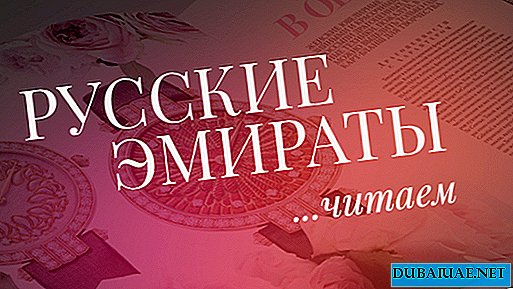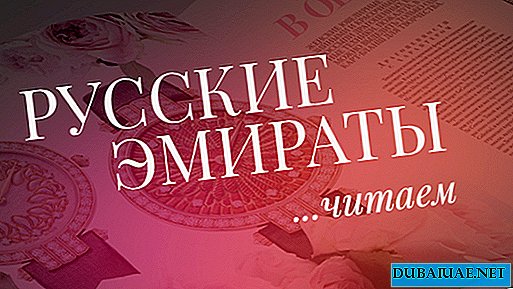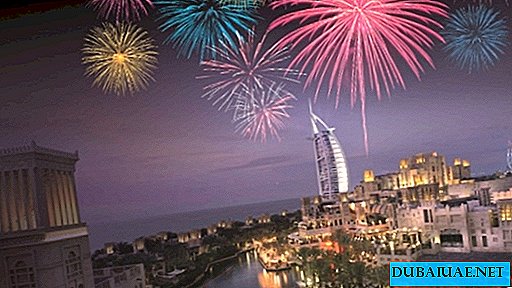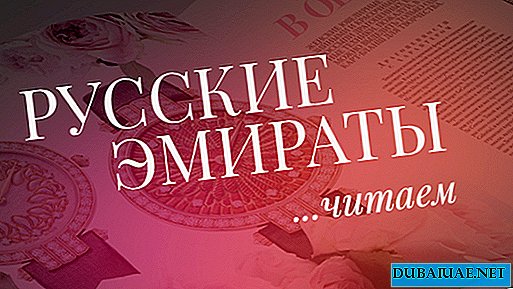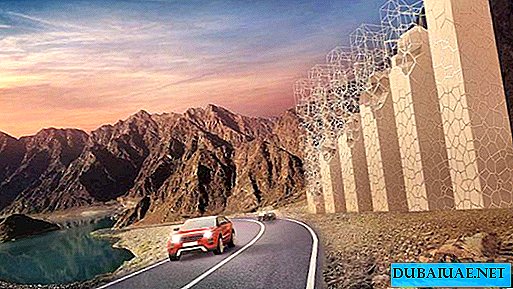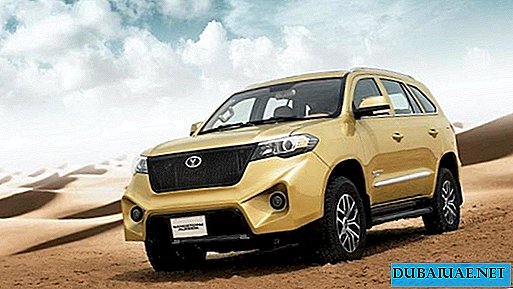Jumeirah
An expensive area of elite mansions. The cozy Jumeirah Beach Park with well-kept gardens is open from 8.00 to 22.30 (on Mondays, entry is only for children under 12 years old and women). Entrance fee is 5 drh per person and 20 drh from the car. Al Safa Park is also located in the area. The history of the park begins back in 1975, the area is 64 hectares. Throughout the territory there are channels through which bridges are thrown. The park is open from 8.00 to 22.30, entrance - 5 drh.
Jumeirah Mosque
This mosque, depicted on a bill of 500 dirhams, is one of the most famous, large and beautiful in Dubai and the only one in the city, open to tourists who are not professing Islam. It is located at the entrance of Dubai Bar to Jumeirah 1, near the Dubai Diving Center. Hourly excursions are organized on Thursdays, Saturdays, Sundays and Tuesdays at 10 a.m.Children are allowed to enter from 5 years old. Ladies should wear long skirts or trousers, the top should always be with long sleeves, a scarf or scarf should be thrown over the head. The mosque will tell you about the architectural traditions and features of such buildings, the main canons of Islam and the history of Arab caliphates.
Entrance - 10 drx
For information: 04 353 6666
Archaeological sites of Jumeirah (Jumeirah Archaeological sites)
In Jumeirah, you can see archaeological sites and artifacts that date back to the periods of the 7th-15th centuries AD (behind the Emirates Hospital). To visit the excavation sites, you must obtain permission from the Dubai Museum. In total, there are 4 archaeological sites in the territory of Dubai, in which there are artifacts older than 2000 years. Three more are located in Al Qusais, Al Sufuh and Hatta.Admission is free, visiting time is from 08.30 to 14.00.
For information: 04 3496874
Majlis "Gorfat Um-Al Sheif" (Majlis Ghorfat Um-Al Sheif)
Built in 1955 as the summer residence of Sheikh Rashid bin Saeed Al Maktoum, the Mejlis is located on Jumeirah by the sea, surrounded by a palm garden with a traditional tree irrigation system. Entrance - 1 drh, visiting time - from 08.30 to 20.30 - on weekdays, from 15.30 to 20.30 - on Fridays.Phone for information: 04 8521374
Union House
This office building on Jumeriah Beach Road is the office of Sheikh Rashid bin Saeed Al Maktoum, the former ruler of Dubai. It was built in honor of the signing of the union treaty on the unification of the emirates of Dubai, Abu Dhabi, Sharjah, Fujairah, Umm Al-Quwain and Ajman. Ras Al Khaimah joined later.Phone for information: 04 3453636
Deira
One of Deira's oldest neighborhoods is called Al-Dag ayah. Here are the old Gold Market (Gold Souk), bus station, seafood market (Fish Market) and two tunnels of Shindag - a car and a pedestrian.
ayah. Here are the old Gold Market (Gold Souk), bus station, seafood market (Fish Market) and two tunnels of Shindag - a car and a pedestrian.
It is unlikely that you will pass by Baniyas Square (aka Nasser Square) - the commercial heart of Dubai. It is here where shop tourists from the CIS mainly shop. Rigga Street is a two-kilometer boulevard that starts near the Al Ghurair shopping center, runs parallel to the bay and ends with a mosque not far from the famous Clock Tower. There are many fashionable boutiques, cafes and eateries, the tables of which are exposed directly to the sidewalk in cool weather. Here, you can get acquainted with any cuisine - Arabic (Al Safadi), Filipino (Golden Fork), Russian ("Fantasy"), Lebanese, American and many others.
In addition, there are several stores in Rigga selling Persian sweets, Arabian clothes and perfumes. These establishments close quite late, around midnight.
Deira ends with a park on the Mamzar Peninsula. Overlooking the skyscrapers of the Emirate of Sharjah, it offers visitors swings, slides, a train ride, bike rental, a cafe (until 8.30 p.m.), sea bays, clean beaches, many barbecue areas, a heated pool and chalet houses. On Fridays, Indian and Arab families go out for a picnic here with tents, hookahs and musical instruments. In addition to them, tourists and representatives of the Russian Diaspora of Dubai "hang out" making appointments on the forum site www.chatru.com.
School and Historical House Al Ahmadiya School & Heritage House
Founded in 1912, Al Ahmadiya was the first city school in Dubai. It is located in the Al Ras quarter. The two-story building was reconstructed in 1995, an educational museum appeared in its place. The oldest part of the building dates from 1890, many extensions were erected later.
On the territory - a large courtyard, a house with 10 rooms and wind towers-barges.
Admission is free, visiting time is from 08.30 to 20.30 - on weekdays, from 14.00 to 20.30 - on Fridays.
Phone for information: 04 2260286
The Naif Museum
Strategically located in Dubai's commercial district, Naif was the first headquarters of the Dubai Police. It was also used as a prison. The clay construction of the special breed “al madar” symbolizes an impregnable stronghold, a stronghold of state security and the rule of law. Construction began in 1939 by order of Sheikh Rashid bin Saeed Al Maktoum, who was then the ruler of the emirate. The territory housed officers' offices and living quarters, as well as a stable for patrol horses. There is still a historical cannon in the courtyard. There was also a prototype of the current police academy.
Admission is free, visiting time is from 08.00 to 19.30 - on weekdays, from 14.30 to 19.30 - on Fridays.
Phone for information: 04 2260286
Nahar Tower (Burj Nahar)
One of the many watchtowers that once guarded the city, it was built in 1870 and renovated in 1992. Located on Al Rashid Street in a picturesque garden. The place is very popular among photographers.
Admission is free, open around the clock.
Bar Dubai
You can get here from Deira using abra boats, as well as buses and taxis crossing the bay along three bridges and through the Shindaga tunnel. (For details, see the section "Transport").
To the left of the Al-Maktoum Bridge is the Creek Park, which is distinguished by a wide variety of flora: 280 species of plants, including giant cacti, grow on 96 hectares. Open from 8.00 to 23.00. Entrance 5 drh.
The park has a children's town, places for barbecue, fishing and rollerblading, as well as a restaurant chain Malik Burger. Bicycle rental is available. The cable car (open until 21.30) offers breathtaking views of the bay and the city. The closest entrance to the cable car is located near Health Care City, in the Ud Metha quarter, famous for the Holy Trinity Church, where Orthodox services are held.
If you came to Dubai for shopping, take a look at Karama - a colorful Indian quarter where you can cheaply buy “copies” of products from Rolex, Gucci, Christian Dior, Bulgari and Louis Vuitton, which are almost indistinguishable from the originals. However, if in addition you want to see the sights, your path lies on the old bazaar, reminiscent of the Golden Market in Deira - and, of course, in the Shindag area.
Here, in a small area, the most well-preserved old buildings are concentrated. In just two to three hours, you can explore the Pearl Catcher Village, the Heritage Village, the home of Sheikh Saeed Al-Maktoum and the Shindag watchtower. Be sure to visit the nearby Divan (Office of the Ruler of Dubai), the Grand Mosque and the Dubai Museum.
Al Fahidi (Bastakia)
 This historic Bar Dubai is located between the city museum at Al Fahidi Fort, Bay Promenade and Musalla Street. Most of the local buildings were built in the late XIX - early XX century. Now the whole quarter is declared a historical monument. In order to imagine what the city looked like in the past, it is worth wandering along its narrow streets. Well-off merchants from Persia settled here; its name itself comes from the Persian province of Bastak. In this prestigious quarter, houses were built and representatives of noble families of the emirate close to the ruler. Now Bastakia is actively being restored (57 houses have been preserved), and soon it will turn into a tourist Mecca, where cafes, restaurants, souvenir shops and art galleries will be located.
This historic Bar Dubai is located between the city museum at Al Fahidi Fort, Bay Promenade and Musalla Street. Most of the local buildings were built in the late XIX - early XX century. Now the whole quarter is declared a historical monument. In order to imagine what the city looked like in the past, it is worth wandering along its narrow streets. Well-off merchants from Persia settled here; its name itself comes from the Persian province of Bastak. In this prestigious quarter, houses were built and representatives of noble families of the emirate close to the ruler. Now Bastakia is actively being restored (57 houses have been preserved), and soon it will turn into a tourist Mecca, where cafes, restaurants, souvenir shops and art galleries will be located.

Grand Mosque
Its tallest in Dubai (70 m) minaret is visible to all who swim to the Old Bar-Dubai Market by abra boat. The mosque is decorated with nine large and forty-five small domes. 1200 people can pray in it at the same time. The modern building was erected at the end of the twentieth century on the site of the old one, built in 1900. This mosque, with its largest Gulf glass stained glass windows, is an important center of Dubai's cultural and religious life.
The entrance to it is open only to Muslims.
Sheikh Saeed Al Maktoum House
Located in Bar Dubai, on the Shindaga Embankment. This is a typical adobe square building typical of local architecture. It was built in 1896 by the ancestors of the current ruler of Dubai. The house has 30 rooms: according to the Arab tradition, several generations of the Maktum clan lived here under one roof.
A permanent exhibition of photographs from the mid-twentieth century tells the story of the transformation of Dubai into a modern city. Connoisseurs of black-and-white photographs will truly enjoy viewing the portraits of Bedouins and group photos of clans against the backdrop of their fortified fortified houses. Collectors will be pleased with the selection of old stamps, bonos and coins, including Indian rupees that went to Dubai during the time of the English protectorate.
Opening hours: Saturday-Thursday - daily from 08.0020.30, on Fridays 15.30-21.30
Diving Village
The village of fishermen and pearl hunters is located in Bar Dubai, in the Shindaga quarter, near the entrance to the tunnel. The current exhibition tells about the life of the first settlers of nomadic tribes, the history of the emergence of trade relations by sea, fishing and pearl mining. There is a scuba diving club in the Village.
Open daily from 8.00 to 22.00. On Friday it works from 8.00 to 11.00 and from 16.00 to 22.00. Tel for information (04) 393 7151. Admission is free.
Dubai Museum
It is easy to find in Bar Dubai, between Bastakia and the Grand Mosque. Fort Al Fahidi, built in 1778 to protect against attacks from the sea, houses two museums - the historical and the military. Before reconstruction in 1971, barracks, a palace and a prison were based in this fort. The museum’s exposition presents in the ground and underground halls the life of the Arab caliphate during the time of the Bedouin tribes and the slave system, household items, artisans and rare finds made of metal and clay, which are 4000 years old. The museum, located behind the Grand Mosque, between Bastakia and the Old Bar-Dubai Market, is open from 8.30 to 19.30 (on Fridays - from 14.00 to 19.30). It includes the courtyard of the old fort and an underground exhibition, the characters of which will allow you to plunge into the atmosphere of old Dubai with all its colors, smells and sounds.
For information phone (04) 353 1862
Al-Wakeel Home Restaurant (Bait Al Wakeel Heritage Restaurant)
Built in 1934 on the embankment of Dubai Bay by Sheikh Rashid bin Saeed Al Maktoum, it is the first office building in Dubai. The reconstruction was completed in 1995, historical elements of the decor were preserved.
Open daily from 12.00 to midnight.
For information: 04 3530530
Sheikh Obaid bin Thani House
Located in the Shindag area, next to the house of Sheikh Saeed, it was built in 1916. The total area of the two-story building is 1250 square meters. meters. It is made of stone and clay in a traditional Arabic style. Used as a museum.
Opening hours: Saturday-Thursday - daily from 08.30-20.30, on Fridays 14.30-20.30
For information: 04 3933240
Dubai Creek Walk with Dinner
A great option to explore Dubai from the water - day and evening cruises on traditional wooden schooners "Dow", which can be ordered from local tour operators. This is a great opportunity to see all the sights of the old city. During the walk, drinks and dinner are offered on board, as well as a small entertainment program. A dinner cruise with dinner is also offered by the modern Bateaux Dubai. From its glazed restaurant deck, where dinner is served with French elegance, you can watch a city passing by at night, illuminated by thousands of colorful lights. Cruises are organized daily; orders for private and corporate parties are accepted.
For information: 04 337 1919
Gold and Diamond Museum (in the center of Dubai Gold & Diamond Park)
Here you can get acquainted with the history of traditional Arabic jewelry and go on excursions in the jewelry factory (with a guide).
Traditional markets
The gold market, the spice market and the textile market will be able to familiarize you with the traditions of the "city of merchants", as they used to call Dubai.
New Gold Souk
It is located on Al Mina Street (leading from Bar Dubai to Jumeirah) opposite the customs of the port named after Sheikh Rashid. The assortment of goods is characterized by a complete mixture of styles, trends and cultures. So, in the Fenoomen store alone you can find jewelry from leading European companies in Austria, Belgium, Holland and Spain, including Swarovsky products. Many stores are richly presented with jewelry in yellow, red and white gold, pearls, black and yellow diamonds.
The center provides a free shuttle from the hotel and a two-story car park. For ladies there are two beauty salons: Daksha's with all kinds of massages, a sauna and mineral baths and Top Ten, where you can go through any cosmetic procedures, do manicures and pedicures.
Ethnographic Village (Heritage Village)
It is located on the Shindag embankment, near the house of Sheikh Saeed and the Divers Village. The village is a walled space, where samples of traditional houses are exposed in the open air. In particular, there is a Bedouin summer house made of trunks and branches of a date palm.
In the village you can buy souvenirs, try traditional flat cakes, visit artisan shops, put henna patterns on your arms and legs, look at the performance of a traditional dance and take pictures in Arabic clothes. There is also a small museum where archaeological finds are exhibited; outside the walls of the village there is a playground where you can ride a camel.
Mushrif Park
The largest park in Dubai is 12 km from the city center, behind Dubai International Airport. The park is popular among both tourists and locals, an ideal place to escape from the bustle of the city. On the green territory of the park, an area of 124 hectares, various types of trees of shrubs and flowers growing in all the Emirates are collected. According to the latest data, the park has more than 30,000 trees and shrubs. In addition to the open spaces of the park are artificial lakes, fountains, alpine slides, pools and playgrounds. Here you can also ride a train that will travel throughout the park, ride a pony and a camel.
The main attraction of Mushrif Park is the International Village. It represents 13 models of houses of different countries and cultures. There is a Danish mill, an Indian wigwam, an English house, a Thai pagoda, an African hut, houses representing the culture of China and Japan, Norway and Indonesia, and of course the United Arab Emirates themselves.
Entrance to the park at a price of 5 drh per person and 30 drh from the car; Entrance to the pool - 5 drh for children and 10 drh for adults.
Opening hours: daily from 08.00-22.00, on Wednesdays - Women's Day.
Dubai Zoo
The oldest zoo not only in the UAE, but also on the Arabian Peninsula. The history of the zoo began with a private collection of exotic animals located in a large garden. In 1971, it was transferred by the owner to the municipality. Now the zoo covers an area of about 2 hectares in the very center of the city in the elite area of Jumeirah. Despite its modest size, the zoo provides shelter for approximately 1,500 animals and birds, including Syrian bears, chimpanzees, African lions and giraffes, Bengal tigers, gazelles, flamingos and snakes.
Entrance to the zoo - 2 drh, Tuesday - day off.
For information: (04) 344 0462
Flamingo Nature Reserve at Ras Al Khor
The reserve in the town of Ras Al Khor together with the surrounding buffer zone covers an area of just over 6 square meters. km This is the only protected water reserve in the country since 1971, on whose territory there are 47 species of plants and 266 species of animals. It is a fragile ecosystem in which reed and mangroves, shrubs, lagoons and swamps are represented. This contributes to the biological diversity of the reserve, in which a large number of birds (including migratory), crustaceans, small mammals and fish are found.
Tourists come here to enjoy the wildlife and the main inhabitants of the reserve and its talisman - beautiful pink flamingos, the number of which reaches 500 individuals. Entrance to the reserve is free of charge by prior registration.
For more information, please call the Dubai Municipality: 04 606 6822/606 6826
Wonder Bus
This "miracle" bus travels both by land and by water. The air-conditioned bus has 44 comfortable seats for passengers and a TV with a wide LCD screen. On a fascinating tour, you will drive through the most interesting Dubai sights, and then plunge into the sea surface of the Dubai Creek. Professional guides will tell you reliable facts from the history of Dubai. The duration of the tour is two hours twice a day. The tour starts from the Bur Juman shopping center.
Price of the trip: for children from 3-12 years old - 75 drx (US $ 20), for adults - 115 drx (US $ 31).
Dubai from the air
Those who are interested in the scale of construction and development of Dubai should fly over the city by helicopter (Aerogulf Services) - from 10 to 30 minutes. Alternative options are seaplane flights over Dubai (Seawings LLC) and balloon flights over the city or in the desert (Balloon Adventures Dubai, Desert Rangers, Voyagers Xtreme).


